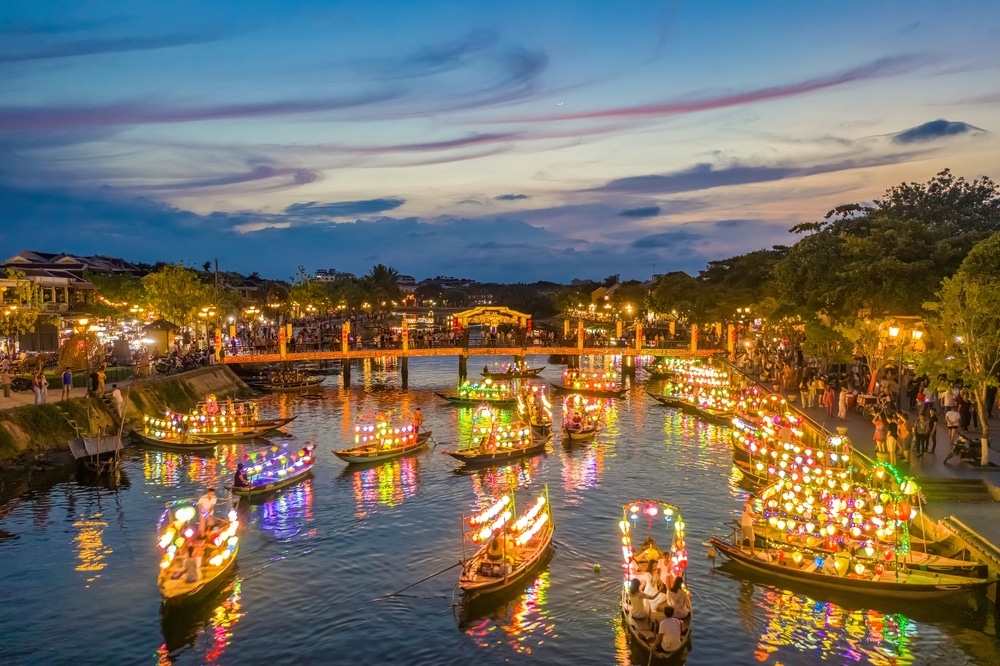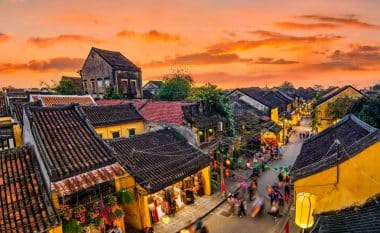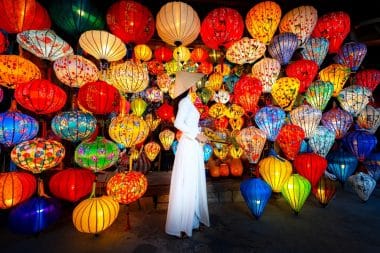
The port city of Hoi An in Vietnam looks back on an impressive history. As part of the famous Silk Road, it was once considered one of the largest and most important ports in Asia. Today it has just 75,000 inhabitants and is still considered one of the absolute insider tips for a visit to Vietnam. The city benefits not only from the still impressive harbor, but also from a mixture of cultures. Vietnamese, Japanese and Chinese can be found in large numbers in the narrow streets. This makes the city a small paradise in the middle of Vietnam.
Vietnam’s historic port and trading city

The fact that the history of Vietnam has a variety of stories to tell should be known to most visitors. However, Hoi An remains a little insider tip next to such metropolises as Ho Chi Minh City. This is mainly due to the fact that the small port city had the peak of its importance around 400 years ago. Almost every European and Asian ship has found its way through the expanded port and unloaded or unloaded goods here.
Hoi An still welcomes visitors today with an old town that can hardly be found in this form in Vietnam. Even in the conflicts of the last decades, the small town has been largely preserved and can therefore still look back on a rich architectural history, architecture and culture. The city also has a lot to offer in terms of cuisine due to the influence of the different cultures and represents restaurants and cuisines from all areas of Asia.
The narrow streets are typical of the city and offer visitors a very special sight. The paths from the harbor lead along old wooden houses, which were still built in the classical style and still provide the Hoi An with its special view today. In addition, the city is rarely full of tourists, even in the high season. Instead, the nightlife can be explored in an almost intimate way.
The most important sights in Hoi An
The old town of Hoi An has been a UNESCO World Heritage Site since 1999 and accordingly there is a lot to discover. In addition to the original houses, it is above all the many small workshops that determine life here. Handicrafts play a major role in the city. If you don’t decide to go shopping, you can not only learn about the history of Hoi An in the city’s museum, for example, but also understand the importance of handicrafts in the city.
In addition to the folk museum, which is probably the best address if you want to learn a little more about the city, the port is of course the first address. It has grown over the years, changed again and again over the centuries and still plays an important role for the city today. Although Hoi An is no longer as important a trading and port city as it may have been 400 years ago, the port still reminds us of its former importance. In addition to the traditional traders, who are there for tourists with their goods, especially in the evening, there are also one or two stalls during the day that have interesting goods to offer.
Ceramics also play a special role in the history of handicrafts in Hoi An. There is a separate museum for this purpose, which explains the importance and history of this special art and has many interesting exhibits to offer for interested visitors. Especially in connection with the temple complex, where this art was perfected, a completely new image of this small town emerges.
Excursions and expeditions around Hoi An

Not only does the city itself have some interesting places to offer, but there are also many opportunities for activities in the surrounding area. The city itself has no beaches, but there are plenty of opportunities to relax and soak up Vietnam’s climate in less than 30 minutes. The temple complex My Son is another popular excursion destination, which also offers a direct insight into the special culture of Vietnam.
If you really want to discover Vietnam in this part of the country, you should not miss the opportunity to sit in one of the restaurants outside the city. There is fresh seafood and local cuisine at affordable prices. In addition, the people of Vietnam are known for their hospitality and take every opportunity to convince visitors of their country and cuisine.
Facts about Hoi-An
- UNESCO World Heritage Site: Hoi An has been recognized as a UNESCO World Heritage Site since 1999. The city is famous for its well-preserved Old Town, which reflects a unique blend of local and foreign influences, including Chinese, Japanese, and European architecture.
- Historic architecture: Hoi An is home to a variety of historic buildings, including old houses, temples, assembly halls, and the famous Japanese Bridge, which was built in the early 17th century.
- Lantern festivals: Hoi An is known for its monthly lantern festivals, where the old town is bathed in a sea of colorful lanterns. These nights offer a magical atmosphere and are a highlight for visitors.
- Tailor-made clothing: The city is also famous for its numerous tailoring shops, where visitors can have custom-made clothing made at affordable prices.
- Dining experience: The local cuisine of Hoi An is unique and offers a variety of delicious dishes. Specialties include cao lầu (a type of noodle soup), white rose (steamed shrimp dumplings), and banh mi (Vietnamese sandwich).
- An Bang Beach: Close to Hoi An is An Bang Beach, one of the most beautiful beaches in Vietnam, which is great for relaxation and water sports.
- Cham Cultural Heritage: Near Hoi An are the ruins of My Son, an ancient temple complex of the Cham culture, which is also a UNESCO World Heritage Site.
- Traditional crafts: Hoi An is a center for traditional crafts, including silk making, ceramics, and wood carving. Visitors can experience workshops and demonstrations of these crafts.
- Ecotourism and rural excursions: The surroundings of Hoi An offer opportunities for ecotourism and rural excursions, where visitors can learn about rural life in Vietnam and participate in activities such as bicycle tours and river cruises.
- Nightlife and markets: Hoi An offers a lively nightlife with numerous bars, cafes and night markets that offer a colourful and lively ambience and invite you to stroll.

